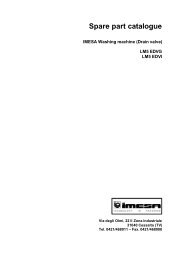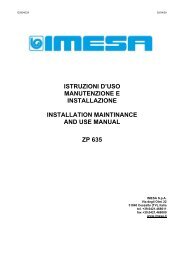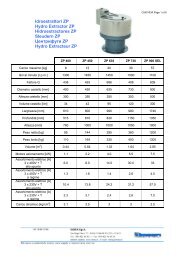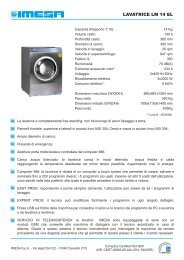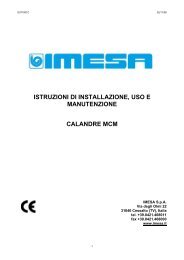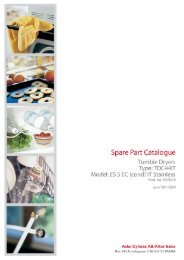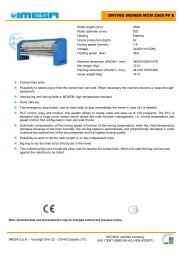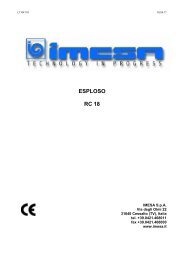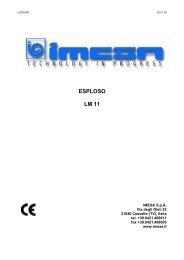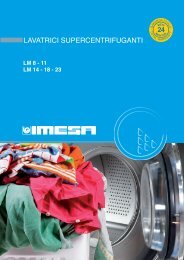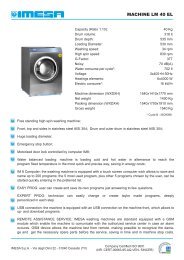S/EP1 - S/EP3 S/EP4 - S/EP5 - IMESA SpA
S/EP1 - S/EP3 S/EP4 - S/EP5 - IMESA SpA
S/EP1 - S/EP3 S/EP4 - S/EP5 - IMESA SpA
You also want an ePaper? Increase the reach of your titles
YUMPU automatically turns print PDFs into web optimized ePapers that Google loves.
17<br />
• The circuit elements is cutout: check the circuit<br />
and re-connect.<br />
7.10 THE ELEMENTS ARE NOT ACTIVATED<br />
• The pressure switch (tav.20-ref.10) is faulty:<br />
replace.<br />
• The contactor coil (tav.30÷30C-ref.12) is burnt out:<br />
replace.<br />
• The level control (tav.30÷30C-ref.3) is faulty:<br />
replace the entire component.<br />
• The electric circuit of the element is cutout: check<br />
the circuit and re-connect.<br />
7.11 THE PRESSURE IN THE BOILER REACHES TOO<br />
HIGH OR TOO LOW VALUES<br />
• The pressure switch (tav.20-ref.10) is not correctly<br />
regulated, re-set correct regulation as follows:<br />
- Loosen the regulation screws B and D, turning the<br />
A screw anti-clockwise.<br />
- Regulate working pressure, indicated in scale C,<br />
at 5 bar, turning the B screw (clockwise to<br />
increase and anti-clockwise to decrease).<br />
- Regulate pressure differential, indicated in scale<br />
E, at 0.6 bar, turning the D screw (anti-clockwise<br />
to increase and clockwise to increase).<br />
- Block the regulation screws B and D, turning the<br />
A screw clockwise.<br />
These regulations censure that pressure inside<br />
the boiler varies from a minimum of 4,4 to a<br />
maximum of 5 bar. When you start up the boiler<br />
after regulating the pressure switch, it is<br />
imperative that you check the pressure on the<br />
pressure gauge (tav.01-ref.12).<br />
• The pressure switch (tav.20-ref.10) is faulty:<br />
replace.<br />
7.12 THE SAFETY VALVE OPENS<br />
Should the safety valve (tav.20-ref.6) open and start to<br />
let steam out, it is necessary to immediately disactivate<br />
the boiler elements (tav.01-ref.8) and switch off the<br />
machine (tav.01-ref.1)<br />
When pressure in the boiler has gone down and the<br />
machine has cooled down, make sure that the various<br />
components inside the machine are not wet; then startup<br />
the boiler again, regulating the pressure switch (see<br />
point 7.11) and bear in mind that working pressure is 5<br />
bar and that the safety valve opens at 5,6 bar.<br />
If the working and blocking pressure switches are<br />
faulty: replace.<br />
If the pressure switch is faulty, replace it.<br />
7.13 THE PUMP DOES NOT START<br />
• The level control (tav.30÷30C-ref.3) is faulty:<br />
replace the entire component.<br />
• The electric circuit of the pump is cutout: check and<br />
re-connect.<br />
• The pump condenser (tav.22-ref.7) is faulty: replace.<br />
• The electric winding of the pump is cutout: if<br />
possible re-connect or re-wind.<br />
7.14 THE PUMP TURNS BUT NO WATER GOES INTO THE<br />
BOILER<br />
• The water solenoid valve (tav.20-ref.2) is faulty:<br />
replace.<br />
• There is air in the pump fan housing: partially<br />
unscrew the cap positioned near the water outlet<br />
pipe, let out all the air and screw up again.<br />
• The check valve (tav.20-ref.3) is blocked: some light<br />
taps on the valve can re-establish functioning, if<br />
this is not sufficient dismantle and clean.<br />
8 INSTRUCTIONS FOR THE DISMANTLING<br />
AND/OR DEMOLITION OF THE MACHINE<br />
To dismantle the machine, carry out the following steps:<br />
• disconnect the hydraulic system;<br />
• disconnect compressed air system;<br />
• disconnect the machine power at the feed cable,<br />
namely at the user’s electric panel to which the feed<br />
cable is connected at its origin;<br />
• disconnect the feed cable from the user’s electric<br />
panel;<br />
• disconnect the Yellow/Green wire from its point of<br />
connection with the user’s earthing system;<br />
• disconnect the feed cable from the terminals and<br />
from the equipotential protection PE.<br />
Disposal of waste equipment by users in private<br />
household in the European Union.<br />
This symbol on the product or on its packaging indicates<br />
that this product must not be disposed of with your other<br />
household waste. Instead, it is your responsibility to<br />
dispose of your waste equipment by handing it over to a<br />
designated collection point for the recycling of waste<br />
electrical and electronic equipment.<br />
The separate collection and recycling of your waste<br />
equipment at the time of disposal will help to conserve<br />
natural resources and ensure that it is recycled in a<br />
manner that protects human health and the environment.<br />
For more information about where you can drop off your<br />
waste equipment for recycling, please contact your local<br />
city office, your household waste disposal service or the<br />
shop where you purchased the product.<br />
9 GUARANTEE CONDITIONS<br />
• All the components and material used in the<br />
machines produced by us, excluding electrical<br />
parts, are guaranteed against manufacturing



